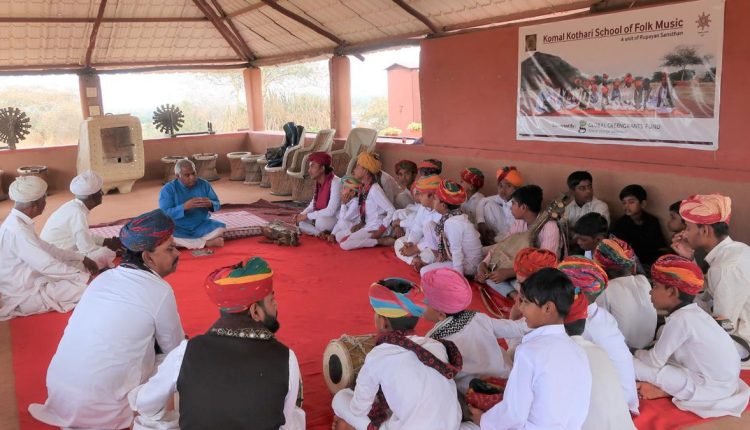
Catching them young:Langa-Manganiyar boys being trained in an artiste camp at
Komal Kothari School of Folk Music in Jodhpur.
| Photo Credit: .Special arrangement
On a still cool March evening in Moklawas, about 15 km from Jodhpur, 35 boys from the Langa and Manganiyar communities sat against the rugged rocky outcrop and sang their hearts out. The themes were as varied as the making or a gorband (an ornament around the camel’s neck), winter migratory birds, and the longing for a beloved. The Arna Jharna Museum, where they performed is special, because it was started by the late Komal Kothari, a renowned folklorist and ethnomusicologist in 2000.
The performance was the culmination of a two-day artiste camp organised to enrol young boys into the Komal Kothari School of Folk Music started in his name. Students were evaluated on their performance by the teachers.
The school aims at preserving the rich musical legacy of the Langa-Manganiyar communities of Muslim folk singers from the desert, mostly living in Rajasthan’s Jaisalmer and Barmer districts, and Sindh province’s Tharparkar and Sanghar districts on the other side of international border.
Boys between 7 and 14 years from underprivileged families are trained over two years in the nuances of ragas, expression, and diction. Participants are guided through performances in Marwari and Sindhi languages and introduced to songs in Saraiki, Dhatti and Thareli. They are taught to play traditional musical instruments such as the khartal (wooden clappers), sarangi (a stringed instrument played with a with bow), and the dholak (double-headed drum). Through the continued patronage of the colourful safa (headgear), kurta (long shirt), and salwar (loose pants), during the performance, the hope is for the amalgam of cultural practices to thrive together.
The popular art form faces challenges of survival since their global performances were halted during the Covid-induced lockdown.
Both the museum and the music school were founded by Rupayan Sansthan, established by Mr. Kothari, a Padma Bhushan recipient, and the late Vijaydan Detha, writer and Padma Shri recipient, in 1960. The idea was to collect folk tales and songs to bring out the richness of the Rajasthani language. The institution has a collection of 20,000 hours of audio recordings of Langa-Manganiyar performances from 1980 to 2003, stored in analogue form.
Rupayan Sansthan’s secretary, Kuldeep Kothari, in his interaction with the boys, expressed the hope that the school would gradually emerge as a resource centre for western Rajasthan’s folk music. “The preservation of oral traditions by imparting training to children will encourage the involvement of the two marginalised communities in nurturing audiences and protecting the history of the desert region,” he said.
Ballads and couplets form a large part of the repertoire. The romantic tales of lovers like Umar-Marvi, Heer-Ranjha, Sohni-Mahiwal, Moomal-Rana, and Sorath-Rao Khangar, have captivated audiences from around the world. This music was supported by wealthy landlords and merchants before Independence.


